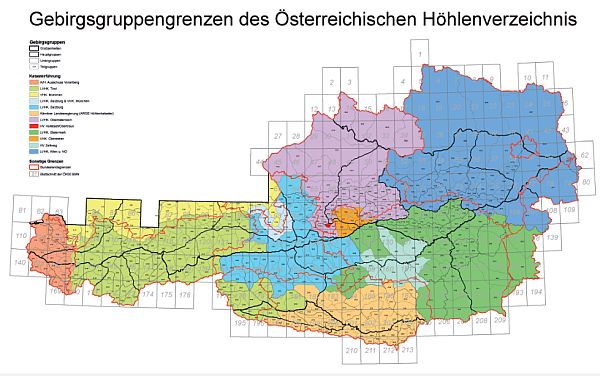
The Höhlenkataster is a national catalogue of all the documented caves in Austria. Within it, each known cave has a unique number. This number comprises two parts - the first part identifies the area in which the cave lies, and the second part is a number allocated to the particular cave, roughly in the order of discovery.
The area numbers divide the country hierarchically, the four digits representing successively smaller areas delineated mainly by natural physical boundaries. CUCC work in area 1623, in which the "1000" (the Großeinheit) represents the Northern Limestone Alps, "1600" (the Hauptgruppe - major mountain group) represents the Totes Gebirge, a mountain area 100km east of Salzburg. The Totes Gebirge falls naturally into three massifs, and some smaller outlying blocks. "1620" (the Untergruppe or massif) is the western massif, and within that, "1623" (the Teilgruppe or part of the massif) is the Loser Augst-Eck plateau.
The area numbers are shown on this online map and we have own own archived copy (June 2020).
Due to our hard work over 40 years, 1623 has the highest density of explored caves (caves per square km) of any of the kataster areas.
A cave which CUCC explored from 2001 is named "Steinbrückenhöhle", which has the number 1623/204. There are presently six entrances, and these are labelled 1623/204A, 204B, 204C, 204D, 204E and 204F. On older discoveries, these numbers were typically painted on the entrance. This has become deprecated with the increase in area of the Nature Reserve (Naturschutzgebiet), and now a more permanent, but less obtrusive, stainless steel tag is bolted on. These numbers enable anyone coming across an entrance not only to see that it has been explored, but also to be able to identify it and look up a description or survey for any cave in Austria. Each area has one locally-based person responsible for allocating "official" numbers in the kataster; in CUCC's 1623 area this is the Verein für Höhlenkunde in Obersteier.
Cavers actually exploring caves in an area may use their own provisional names or numbers (many of which appear in these pages). CUCC use easily fabricated aluminium tags with our own internal number as a temporary measure during early exploration; our practices are documented in the Prospecting Handbook. Once a cave has been accurately located and explored sufficiently to count as a significant find, a form is filled out and sent to the VfHO, who will allocate a final kataster number.
The VOH maintains a current list of longest and deepest caves in Austria and their Austrian Caving Handbook is well-worth skimming through. This is the master document defining the caving areas and the Austrian cave classification system. In 2022 The Schwatzmooskögel System is 10th deepest and 2nd longest in Austria.
If caves have been explored by groups not recognised by the local cavers, or caves have been inadequately documented and may be rediscoveries, then they may still be known only by old provisional numbers. In our area, there are a few insignificant caves found by CUCC which have numbers like "B8" (though we are currently documenting the ones we can actually find more fully to give them "proper" numbers). Further north, there are numbers like "LA23" or "BS17" explored by Lancaster University Speleological Society and the University of Bristol Spelaeological Society respectively.
The Austrians periodically publish summary lists of caves for each area, and within these lists, each cave has a status code, such as "3/S/E +". The number represents the extent of the cave on a scale from 0-9, the letters denote the sort of cave it is, and the symbol at the end stands for the current state of exploration.
| Length | Depth | code |
|---|---|---|
| unknown | unknown | 0 |
| 5m but <50m | 5m but <50m | 1 |
| 50m but <500m | 50m but <100m | 2 |
| 500m but <5km | 100m but <200m | 3 |
| 5km but <10km | 200m but <500m | 4 |
| 10km but <25km | 500m but <750m | 5 |
| 25km but <50km | 750m but <1000m | 6 |
| 50km but <100km | 1000m but <1250m | 7 |
| 100km but <500km | 1250m but <1500m | 8 |
| 500km or over | 1500m or over | 9 |
If length and depth give different codes, then the cave gets the greater of the two.
So, for instance, Kaninchenhöhle, 1623/161, gets the code "5/S/E ×", because it is 22 km long and just over 500m deep (both rate a "5"), is principally a vertical cave, but also has passages with ice, and been extensively explored, but there are still many leads to push.
Some of our older cave descriptions (mostly for caves we have not explored and know little about) use an older system:
The boundaries of the or Teilgruppengrenzen:
Altaussee - Augstbach - Blaa-Alm (894m) - Forststrasse bis Naglesteg (sudwestlich Naglbrundl) - Rettenbach aufwarts bis 860m Seehohe - Graben erst nordostlich, dann nordlich entlang der ostseitigen Felsen aufwarts zum Hauslboden - Schossboden (Kote 1171) - aus dessen Senke 1km in einem schwach ausgepragten Graben fast gerade nach Nordsten aufwarts zum Beginn der Latschenregion (etwa 1550m) - nun 500m Richtung Ostnordost zum Sudfuss des Schoeneck (Kote 1696), rund 150m sudlich der Gipfelkote in 1650m Seehohe - von dort zunachst rund 500m nach Ostnordost, dann 400m nach Osten (zuletzt am Sudrand der grossen Doline, Kote 1664) zur Schimarkierung, die etwa 100m westlich von Kote 1711 verlauft - entlang dieser Schiroute 600m Richtung Nord bzw. Nordnordost bis run 1800m Seehohe - der nach Nordosten umbiegenden Schimarkierung weiter folgend, etwa 300m ostlich am Griesskogel (2006m) vorbei, zur Einsattelung (ca. 1920m) zwischen Rauchfang (1971m) und Hohem Augsteck (1961m) - Schimarkierung Richtung Ostsudost 2.5km zur Wildenseehutte (1525m) - markierter Steig sudwestlich uber Augstwiesen, Hochklapfsattel, Oberwasseralm und Stummernalm zum Altausseer See - Altaussee.